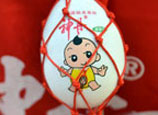
 |
| Most people carrying on the Five Tiger Stick tradition are men in their 20s and 30s without jobs. Photo: Li Hao/GT |
Ge Song used to work as a driver, but now he spends his workdays dodging and parrying strikes from a wooden quarterstaff. He's not always fast enough.
"It's common that we get hit once every couple of days. Because once you can't keep up with the pace, or you don't remember the next move, the stick hits you," said Ge, 30, who joined the team last October.
Ge has been recruited to carry on the art of Five Tiger Stick, an blend of dance and stick-fighting performed at temple fairs around the city. Traditionally, Five Tiger Stick is passed down by oral instructions face-to-face from generation to generation, only to villagers in Liulangzhuang village. But now the art is fading.
Sixty years ago, coach Chi Yongfu was picked as one of the 20 young children to learn this skill from a pool of almost 200. But now it's not easy to recruit small kids.
"Nowadays the parents have only one child, and place high hopes on them. Most parents would like their children to focus on studying at school. Few parents are willing to let their children spend much time on this," Chi said.
Five Tiger Stick was named as part of Beijing's Intangible Cultural Heritage as a traditional dance in 2009. This led to Chi's team being organized in 2010, with the township government subsidizing each person 2,500 yuan a month.
Those who applied to join this team are mostly in their twenties or thirties who don't have jobs. The youngest is 17.
Chi considers this "too old to begin learning" because the body doesn't have a solid martial arts foundation, which requires a many hours of practice from a young age.
"The ideal age to start is six to 12 years old. If your body foundation is not good enough, the gestures will be ugly. Maybe it's OK to watch for amateurs, but we can tell that it's not authentic," said Chi, who is now 67.
He said that some moves, such as suddenly jumping up with a somersault from lying on the floor, are almost impossible for those who start to practice above 20 years old.
Ge, the former driver, says everyone on the team has injuries. "Once my neck was injured and it took me a week to recover. I got hurt when I tried to jump up from lying on the floor by way of a somersault. It's hard for me because I am a bit fat and have a big belly. I have been trying to lose weight," he said.
Five Tiger Stick has been practiced in Liulangzhuang village for over 300 years since the rule of Emperor Kangxi (1654-1722). It was performed in the Qing imperial palace to entertain emperors. The name comes from a folk story which can be dated back to the Song dynasty (960-1279). Before he become emperor, the first emperor of Song dynasty Zhao Kuangyin was extorted by five local bullies known as the five tigers. They all fought using wooden staffs, so the form is called Five Tiger Stick. But this auspicious history does not impress everyone.
"My wife thinks it's a just so-so job. I don't earn as much as I used to when I was a driver. She worries that I get hurt sometimes. But I think it's better for my health. And I have more free time," said Ge.
















 Many register as couples on '5.20' day
Many register as couples on '5.20' day


![]()
